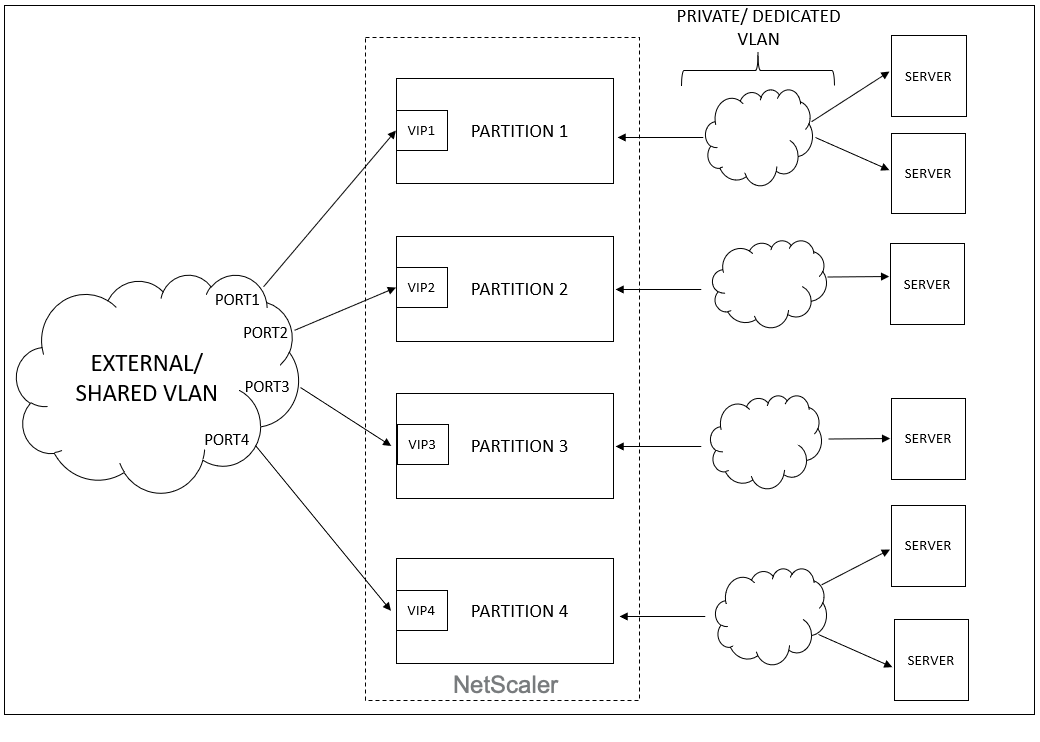Shared VLAN support for admin partitions
For tenants connecting from private networks, the NetScaler® Application Delivery Management (ADM) supports isolation policy so that each tenant has its own dedicated partition, a dedicated VLAN, and dedicated servers. For tenants connecting from public networks, a dedicated VLAN will require too many IP addresses to be used. A shared VLAN circumvents this problem by creating one virtual IP address on each partition thus creating a single IP subnet.

When an tenant configures a VIP or a listener, an admin partition is created in the NetScaler device for that tenant. All load balancer configuration is pushed to that admin partition that is created. If the tenant is using a shared network or an external network to create a load balancer, then the VLAN of that network is added and the sharing feature is enabled. When a different tenant uses the same shared network to create its load balancer, the VLAN is not added to the NetScaler again, but the VLAN will be bound to the second partition as well. Thus, any tenant who uses the same shared network gets a partition which is bound to the same VLAN.
The NetScaler ADM supports virtual destination MAC address. When tenants share a VLAN, the NetScaler ADM assigns different MAC addresses to the partition on the NetScaler device. This allows a VLAN to be shared across partitions or across all tenants and all traffic domains.
Configuring Shared VLAN from NetScaler Instance
-
In a NetScaler instance, navigate to Configuration > System > Network > VLANs, select a VLAN profile, and click Edit to set the partition sharing parameter.
-
On the Configure VLAN page, select the Partitions Sharing check box.
-
Click OK.

Configuring Shared VLAN from OpenStack Orchestration
-
In OpenStack, navigate to Admin > System > Networks, and then click Create Network.
-
In Create Network, set the following parameters:
-
Name - enter the name of the network
-
Project - select a project form the drop-down list
-
Provider Network Type - select VLAN from the drop-down list. This defines that the virtual network is established as VLAN.
-
Physical Network - the default physical network is selected here. You can edit this.
-
Admin State - by default, the administrative state of the network is UP
-
Select Shared and External Network to define that the VLAN is shared and is using an external network.
-
Click Create Network.

The official version of this content is in English. Some of the Cloud Software Group documentation content is machine translated for your convenience only. Cloud Software Group has no control over machine-translated content, which may contain errors, inaccuracies or unsuitable language. No warranty of any kind, either expressed or implied, is made as to the accuracy, reliability, suitability, or correctness of any translations made from the English original into any other language, or that your Cloud Software Group product or service conforms to any machine translated content, and any warranty provided under the applicable end user license agreement or terms of service, or any other agreement with Cloud Software Group, that the product or service conforms with any documentation shall not apply to the extent that such documentation has been machine translated. Cloud Software Group will not be held responsible for any damage or issues that may arise from using machine-translated content.
DIESER DIENST KANN ÜBERSETZUNGEN ENTHALTEN, DIE VON GOOGLE BEREITGESTELLT WERDEN. GOOGLE LEHNT JEDE AUSDRÜCKLICHE ODER STILLSCHWEIGENDE GEWÄHRLEISTUNG IN BEZUG AUF DIE ÜBERSETZUNGEN AB, EINSCHLIESSLICH JEGLICHER GEWÄHRLEISTUNG DER GENAUIGKEIT, ZUVERLÄSSIGKEIT UND JEGLICHER STILLSCHWEIGENDEN GEWÄHRLEISTUNG DER MARKTGÄNGIGKEIT, DER EIGNUNG FÜR EINEN BESTIMMTEN ZWECK UND DER NICHTVERLETZUNG VON RECHTEN DRITTER.
CE SERVICE PEUT CONTENIR DES TRADUCTIONS FOURNIES PAR GOOGLE. GOOGLE EXCLUT TOUTE GARANTIE RELATIVE AUX TRADUCTIONS, EXPRESSE OU IMPLICITE, Y COMPRIS TOUTE GARANTIE D'EXACTITUDE, DE FIABILITÉ ET TOUTE GARANTIE IMPLICITE DE QUALITÉ MARCHANDE, D'ADÉQUATION À UN USAGE PARTICULIER ET D'ABSENCE DE CONTREFAÇON.
ESTE SERVICIO PUEDE CONTENER TRADUCCIONES CON TECNOLOGÍA DE GOOGLE. GOOGLE RENUNCIA A TODAS LAS GARANTÍAS RELACIONADAS CON LAS TRADUCCIONES, TANTO IMPLÍCITAS COMO EXPLÍCITAS, INCLUIDAS LAS GARANTÍAS DE EXACTITUD, FIABILIDAD Y OTRAS GARANTÍAS IMPLÍCITAS DE COMERCIABILIDAD, IDONEIDAD PARA UN FIN EN PARTICULAR Y AUSENCIA DE INFRACCIÓN DE DERECHOS.
本服务可能包含由 Google 提供技术支持的翻译。Google 对这些翻译内容不做任何明示或暗示的保证,包括对准确性、可靠性的任何保证以及对适销性、特定用途的适用性和非侵权性的任何暗示保证。
このサービスには、Google が提供する翻訳が含まれている可能性があります。Google は翻訳について、明示的か黙示的かを問わず、精度と信頼性に関するあらゆる保証、および商品性、特定目的への適合性、第三者の権利を侵害しないことに関するあらゆる黙示的保証を含め、一切保証しません。
ESTE SERVIÇO PODE CONTER TRADUÇÕES FORNECIDAS PELO GOOGLE. O GOOGLE SE EXIME DE TODAS AS GARANTIAS RELACIONADAS COM AS TRADUÇÕES, EXPRESSAS OU IMPLÍCITAS, INCLUINDO QUALQUER GARANTIA DE PRECISÃO, CONFIABILIDADE E QUALQUER GARANTIA IMPLÍCITA DE COMERCIALIZAÇÃO, ADEQUAÇÃO A UM PROPÓSITO ESPECÍFICO E NÃO INFRAÇÃO.


